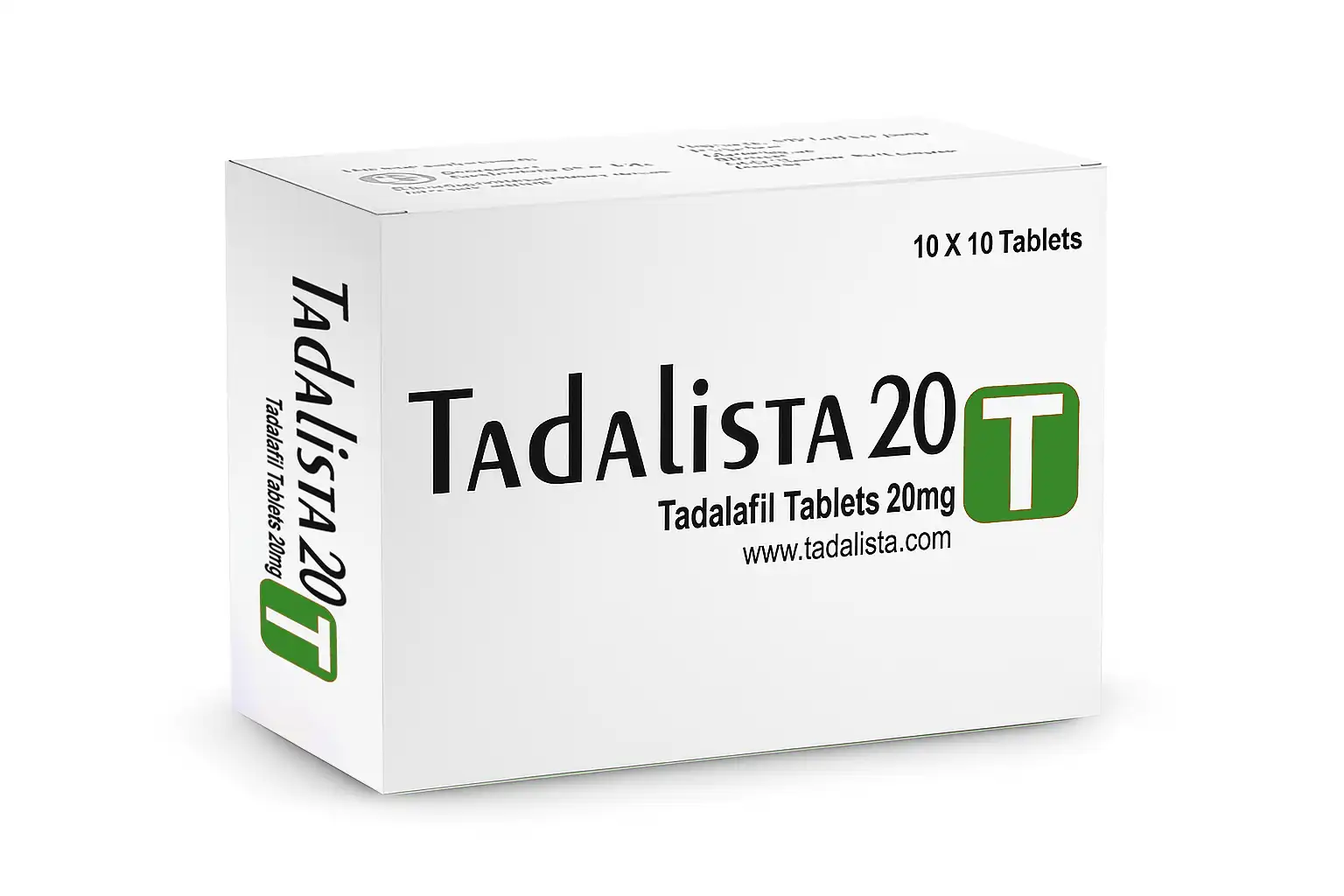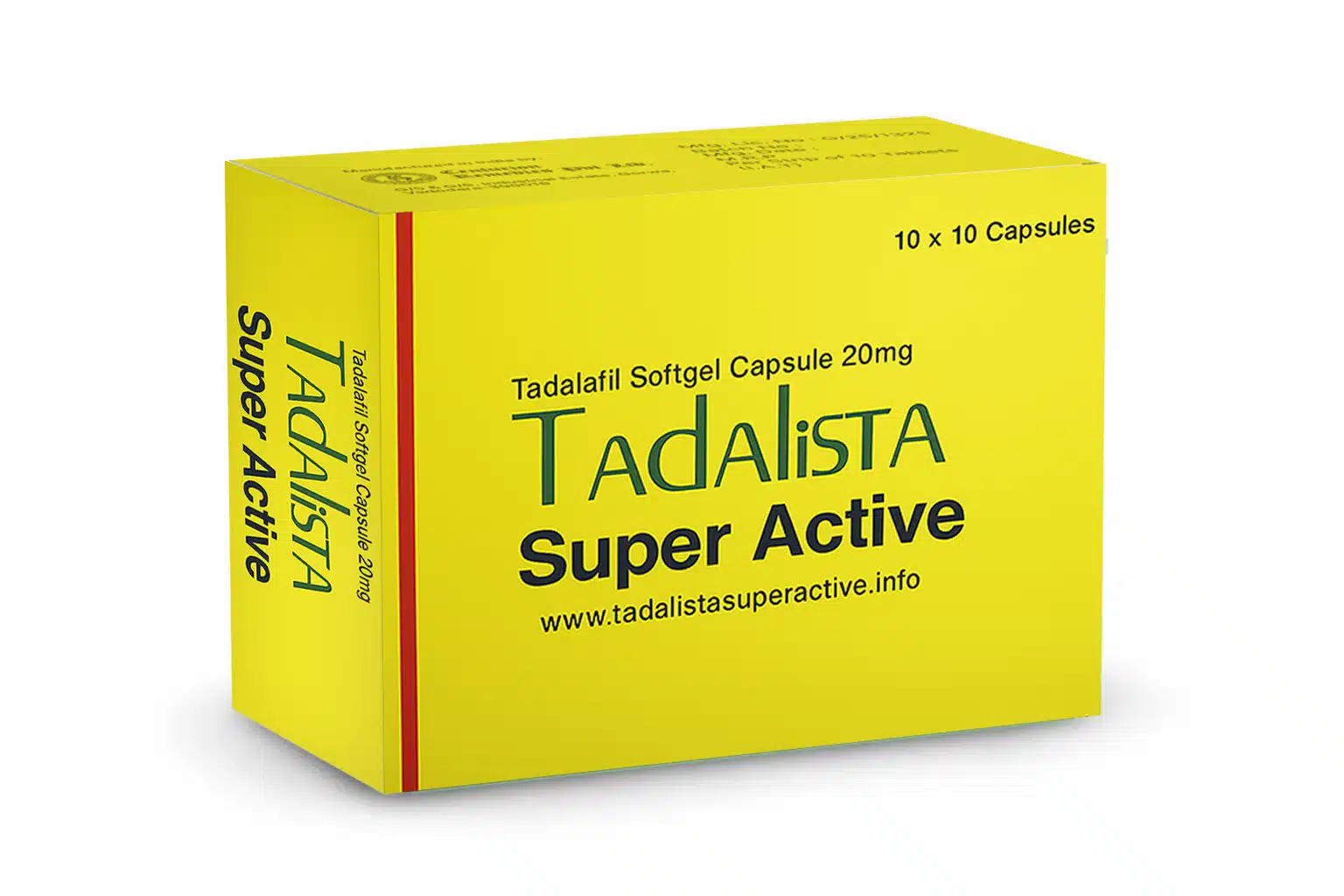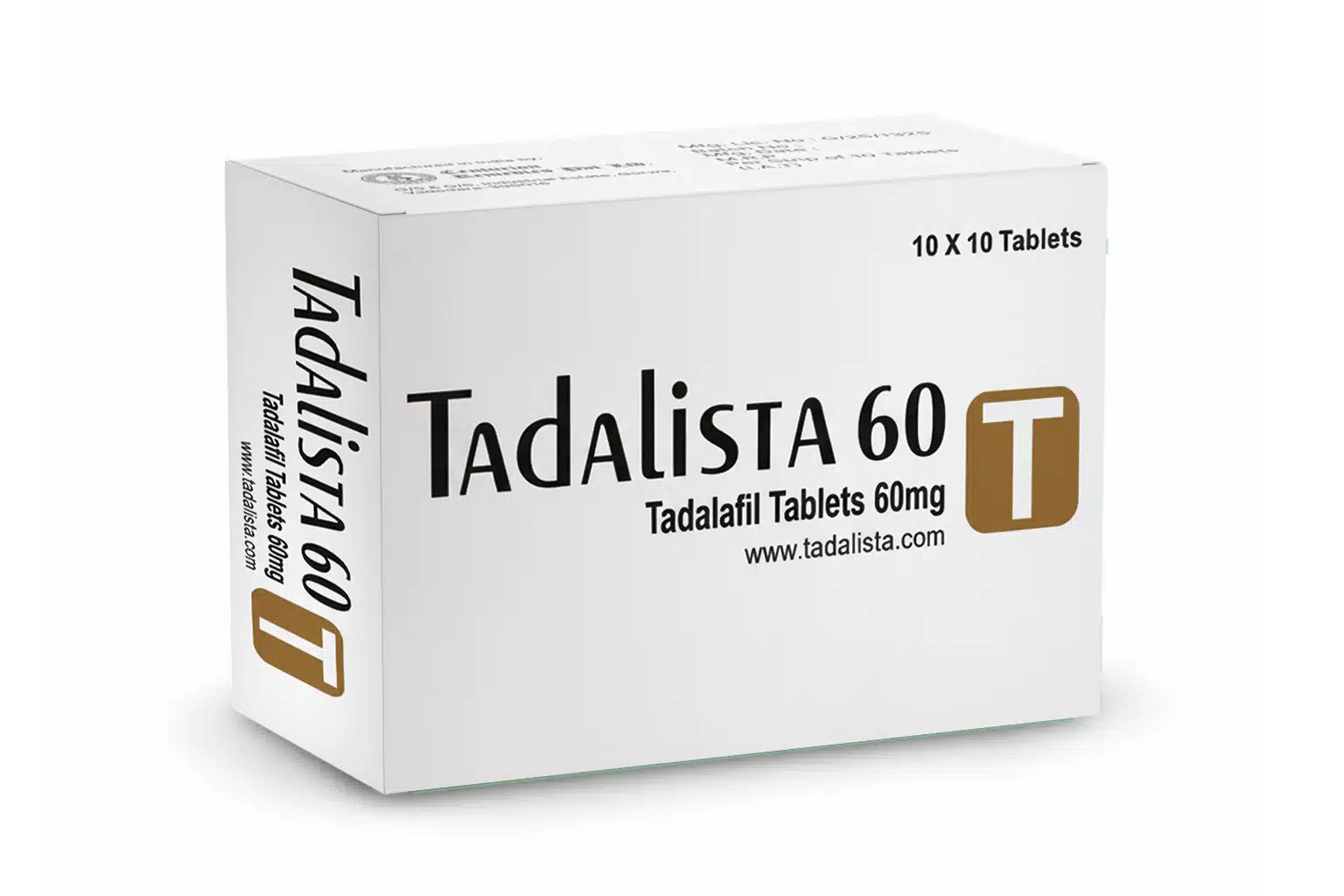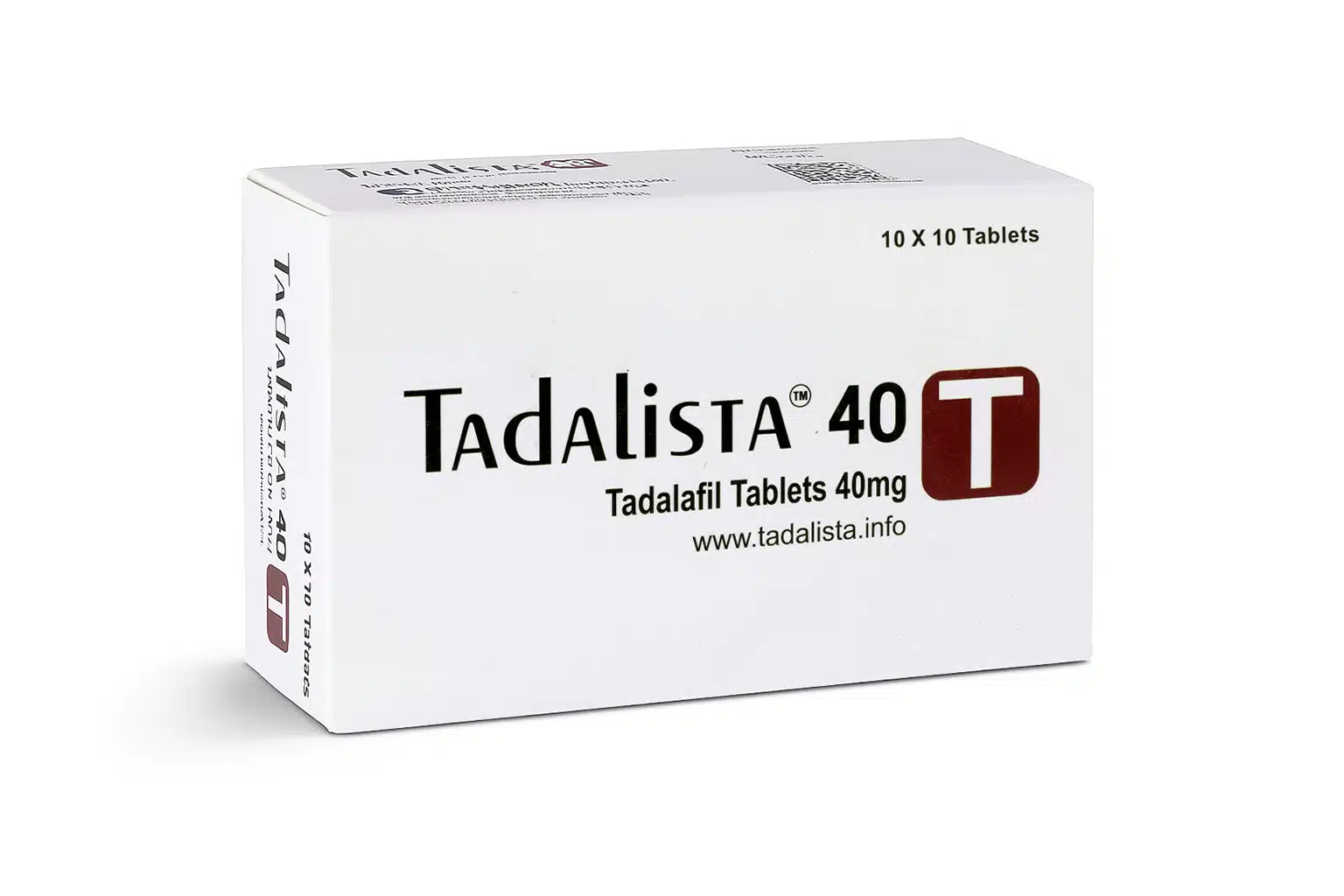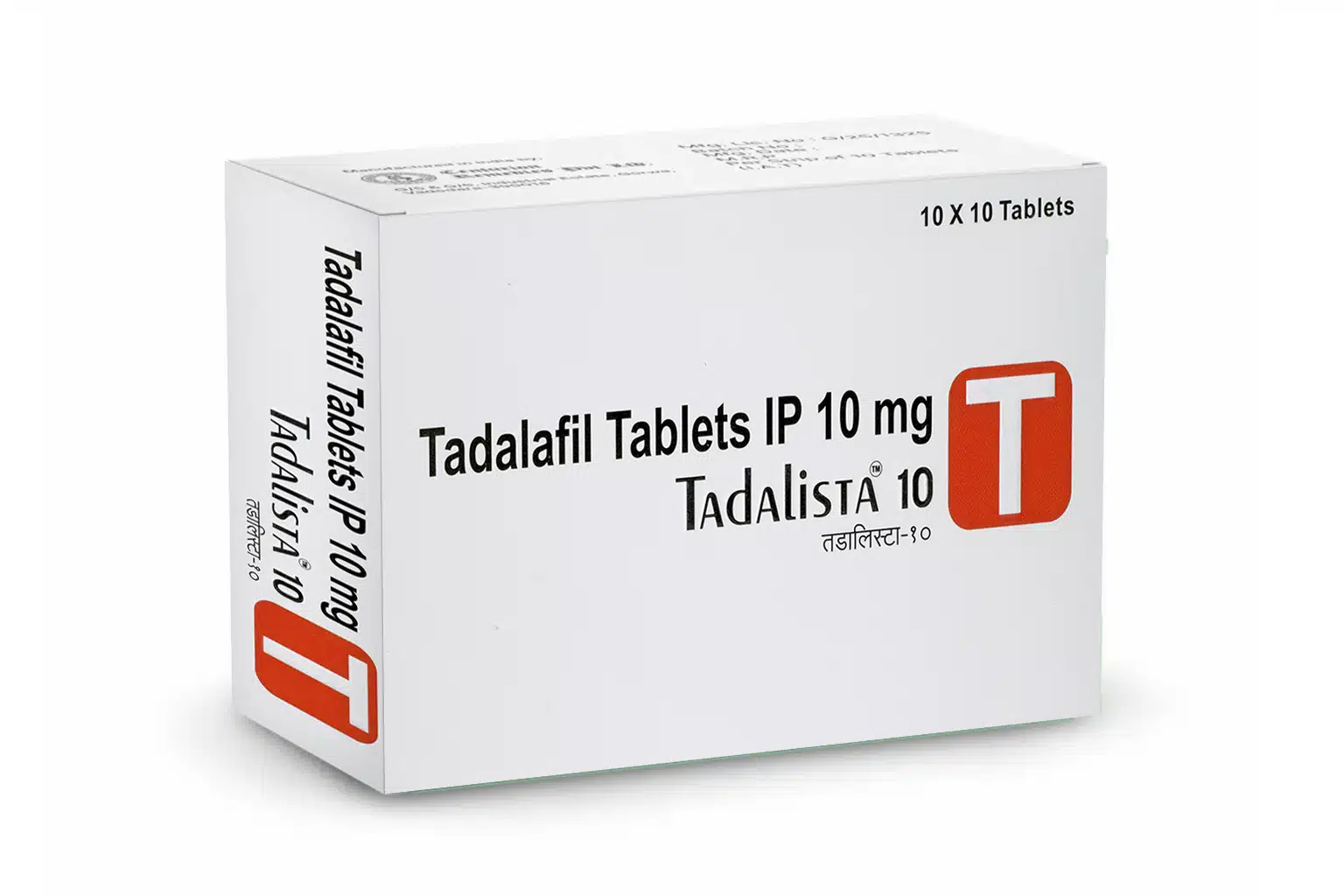Tadalista
Tadalista is medication applied to address erectile dysfunction in men. The active ingredient, Tadalafil, belongs to a class of medication known as phosphodiesterase type 5 (PDE5) inhibitors. Tadalista increases blood flow to the penis during sexual stimulation, allowing men to attain and maintain hard erections.
-
Tadalista 20mg
$25.00 – $253.00Price range: $25.00 through $253.00Rated 4.00 out of 5Shop Now This product has multiple variants. The options may be chosen on the product page -
Tadalista Super Active 20 Mg
$25.00 – $253.00Price range: $25.00 through $253.00Rated 5.00 out of 5Shop Now This product has multiple variants. The options may be chosen on the product page -
Tadalista 60 Mg
$36.00 – $364.00Price range: $36.00 through $364.00Rated 5.00 out of 5Shop Now This product has multiple variants. The options may be chosen on the product page -
Tadalista 40 Mg
$28.00 – $285.00Price range: $28.00 through $285.00Rated 4.00 out of 5Shop Now This product has multiple variants. The options may be chosen on the product page -
Tadalista 10 Mg
$20.00 – $206.00Price range: $20.00 through $206.00Rated 5.00 out of 5Shop Now This product has multiple variants. The options may be chosen on the product page -
Tadalista 5 Mg
$19.00 – $190.00Price range: $19.00 through $190.00Rated 4.00 out of 5Shop Now This product has multiple variants. The options may be chosen on the product page
| Product Details (Tadalista) | |
|---|---|
| Composition | Active ingredients: Tadalafil Inactive ingredients: Fillers: Lactose
|
| Packaging Type | Box |
| Pack Size | 1×10 Tablets |
| Dosage | 2.5 mg, 5 mg |
| Active ingredients | Tadalafil: A phosphodiesterase type 5 (PDE5) inhibitor that helps treat erectile dysfunction (ED). |
| Manufacturer | Abbott Healthcare Pvt Ltd |
| Shelf Life | 24 months |
| Usages | Erectile dysfunction, Benign Prostatic Hyperplasia, and Primary Pulmonary Hypertension |
| Country of Origin | Made in India |
| Medication | Active ingredients | Dosage | Duration of Action | Uses |
|---|---|---|---|---|
| Tadalista 5 mg | Tadalafil | 5 mg | Almost up to 36 hours | ED Treatment |
| Tadalista 10 mg | Tadalafil | 10 mg | Almost up to 36 hours | ED Treatment |
| Tadalista 20 mg | Tadalafil | 20 mg | Almost up to 36 hours | ED Treatment |
| Tadalista 40 mg | Tadalafil | 40 mg | Almost up to 36 hours | ED Treatment |
| Tadalista 60 mg | Tadalafil | 60 mg | Almost up to 36 hours | ED Treatment |
| Tadalista Superactive 20 mg | Tadalafil | 20 mg | Almost up to 36 hours | ED Treatment |

Dosage
Doses of Tadalista is based on the condition and individual requirements:
- For Erectile Dysfunction (ED) purpose, initial dose is usually 5 mg daily or as needed 40 mg, taken prior to sexual intercourse.
- For Benign Prostatic Hyperplasia (BPH), 5 mg daily
- For PAH (Pulmonary Arterial Hypertension), Dosage may vary from individual to individual, consult a doctor.
Applications of Tadalafil
Tadalista is most commonly prescribed for:
- Erectile Dysfunction: Managing ED in men, facilitating achieving and sustaining erections.
- Benign Prostatic Hyperplasia: Managing symptoms such as urgency to urinate, poor stream, and incontinence.
- Pulmonary Arterial Hypertension: Decreasing pulmonary blood vessel pressure, enhancing exercise capacity.
Benefits of using Vidalista medication
- Long duration of action up to 36 hours, enabling more spontaneity.
- Enhanced erectile function, more confidence, and satisfaction.
- Enhanced urine flow and lessened symptoms for Benign Prostatic Hyperplasia.
How Does Tadalista Work?
Tadalista functions by inhibiting the phosphodiesterase type 5 (PDE5) enzyme that breaks down cyclic guanosine monophosphate (cGMP). cGMP is a molecule that causes the smooth muscles in the penis to relax, which leads to more blood flow and results in a strong and long-lasting erection. With the inhibition of PDE5, Tadalista raises the levels of cGMP, which helps men with ED to get and sustain an erection.
Common side effects of Vidalista are:
- Headache
- Dizziness
- Flushing
- Nasal congestion
- Back pain
- Muscle pain
- Indigestion
Severe side effects can occur, including:
- Priapism (prolonged erection)
- Sudden vision loss
- Sudden hearing loss
- Heart problems
Interactions
Tadalafil interactions are classified into several categories:
- Drug interactions
- Food interactions
- Disease interactions
Drug Interactions:
- CYP3A4 Inhibitors (e.g., ketoconazole, ritonavir): Increase Tadalafil levels, CYP3A4 inhibitors can retard the metabolism of Tadalafil, with consequent higher levels and a greater risk of adverse effects.
- CYP3A4 Inducers (e.g., rifampicin, bosentan): Reduce tadalafil concentration, CYP3A4 inducers may speed up Tadalafil metabolism, weakening is efficacy.
- Nitrates (e.g., nitroglycerin, isosorbide dinitrate): Severe hypotension, Tadalafil may enhance the blood pressure-lowering effects of nitrates and cause potentially hazardous reductions in blood pressure.
- Alpha-blockers (e.g., doxazosin, tamsulosin): Increase risk of hypotension, Tadalafil has the potential to increase alpha-blockers hypotensive effects.
- Antihypertensives: (e.g., ACE inhibitors, beta-blockers): Additive hypotensive effects, Tadalafil has the potential to enhance the blood pressure-reducing effects of these medications, so the risk of hypotension is increased.
- Alcohol: Increased the risk of hypotension and side effects: Alcohol can potentiate the blood pressure-lowering action of Tadalafil and enhance the risk of side effects such as dizziness and headache.
- Other PDE5 Inhibitors: Increased risk of side effects, Concomitant use of Tadalafil with other PDE5 (e.g., Sildenafil, Vardenafil) may raise the risk of side effects because of additive effects.
Therapeutic Suggestions
- Adjustments in dose can be made when Tadalafil is administered with CYP3A4 inhibitors or inducers.
- Concomitant use should be avoided of Tadalafil with nitrates or other PDE5 inhibitors.
- Blood pressure should be monitored when Tadalafil is administered with antihypertensives or alpha-blockers.
- Alcohol should be consumed in limited amounts to prevent side effects.
Pharmacokinetics
Pharmacokinetic Interaction takes place when a drug influences the Absorption, Distribution, Metabolism, or excretion (ADME) of another drug. This may result in an alteration in the concentration of one or both drugs in the body and thus may alter their effects or enhance the risk of side effects.
There are various categories of Pharmacokinetic interactions:
- Absorption interaction
- Distribution interaction
- Metabolism interaction
- Erection Interaction
Pharmacokinetic interactions are very important in anticipating and managing future drug interactions, allowing for safe and effective therapy.
Does Tadalafil have any pharmacokinetic interaction?
Yes, Tadalafil also has a number of pharmacokinetic interactions. Tadalafil can be metabolized by cytochrome P450 (CYP) 3A4, and as bosentan induces CYP2C9 and CYP3A4, a pharmacokinetic interaction is possible between these agents.
Food Interactions
- Grapefruit: Grapefruit and grapefruit juice may raise levels of tadalafil in the blood, which could result in higher side effects.
- Alcohol: Drinking a lot of alcohol with tadalafil might cause side effects to be greater, such as dizziness, headache, and low blood pressure. Taking moderate alcohol is recommended.
Disease Interactions
- Cardiovascular disease: People with heart disease or high blood pressure might have increased risks when using tadalafil.
- Liver or kidney impairment: Abnormal liver or kidney function may change the metabolism and elimination of tadalafil, requiring dose modification.
- Retinal disorders: Diseases such as retinitis pigmentosa might be worsened by tadalafil.
- Priapism: Priapism, a lasting erection of the penis, may occur with tadalafil in some patients.
Contraindications of Tadalafil
Tadalafil, a drug employed to cure erectile dysfunction (ED) and benign prostatic hyperplasia (BPH), has specific contraindications:
1. Nitrates
- Forbidden usage: Tadalafil must not be used with nitrates, for it results in a remarkable fall in blood pressure.
- Examples of nitrates: Nitroglycerin, isosorbide dinitrate, and isosorbide mononitrate.
2. Guanylate Cyclase Stimulators
- Forbidden use: Tadalafil is not recommended to be used with guanylate cyclase stimulators like riociguat since it can also lead to a sudden drop in blood pressure.
3. Hypersensitivity
- Allergic reactions: If you are hypersensitive or allergic to tadalafil or any component of the drug, you should avoid taking it.
4. Severe Health Conditions
- Heart conditions: Some heart conditions, e.g., severe heart failure or uncontrolled hypertension, might necessitate caution or contraindication.
- Liver or kidney problems: Severe liver or kidney dysfunction can necessitate dose modification or contraindication.
5. Other Considerations
- Age and health status: Elderly or patients with specific health conditions might need dose adjustment or more intensive monitoring.
- Interactions with other medications: Tadalafil may interact with other drugs, so it’s important to tell your physician all the medications you’re taking.
Reducing Interactions
- Discuss medication lists with healthcare professionals on a regular basis
- Follow dosage directions.
- Reduce alcohol intake.
- Avoid grapefruit and grapefruit juice.
- Inform medical professionals regarding any health conditions or medication being used.
Precautions
- Cardiovascular disease: Tadalista should be used cautiously in patients with cardiovascular disease.
- Hepatic impairment: Tadalista should be used cautiously in patients with severe hepatic impairment.
- Renal impairment: Tadalista should be used cautiously in patients with severe renal impairment.
Conclusion
Tadalista is a drug that is prescribed for erectile dysfunction (ED), benign prostatic hyperplasia (BPH), and pulmonary arterial hypertension (PAH). It works by inhibiting the action of phosphodiesterase type 5 (PDE5), which results in elevated levels of cyclic guanosine monophosphate (cGMP) and enhanced blood flow. It is recommended to use after consulting your physician.
References
FAQ's
1) What for Tadalista is used?
Tadalista is used to treat erectile dysfunction.
2) How long does Tadalista work?
The effects of Tadalista can lasts up to 36 hours.
3) What can be the recommended dosage for Tadalista?
For erectile dysfunction starting dose is typically 10 mg.
4) How long does Tadalafil last?
Tadalafil can last as long as 36 hours.
5) Is Tadalista safe for everyone?
It is safe but one with certain medical conditions, such as heart, liver, and kidney should avoid taking it or consult your physician.
Customer Reviews

Lucas

Jhon Deo

Maria Mak

Mark Milligan
Join Now For Exclusive Offers
Unlock the world of wellness with exciting deals and informative content

